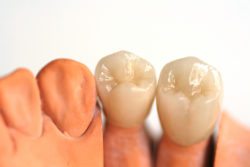 When the structure or health of a tooth becomes compromised, we may recommend a solution with a lifelike dental restoration. Strong and durable, these restorations can return your tooth to optimal health and function. Do you need a crown, or possibly a partial crown, to repair your tooth? How do these options differ?
When the structure or health of a tooth becomes compromised, we may recommend a solution with a lifelike dental restoration. Strong and durable, these restorations can return your tooth to optimal health and function. Do you need a crown, or possibly a partial crown, to repair your tooth? How do these options differ?
Frequently Asked Questions About Crowns and Partial Crowns
Question: What oral health concerns can you address with a restoration?
Answer: We can use a restoration to repair a tooth, including minor chips or serious breakage. We can also fix fractures and reshape malformed teeth. We’ve employed them to address cosmetic issues, or anchor dental bridges in place. We can fix serious cavities, infections, or even restore single tooth dental implants.
Question: How does a dental crown work?
Answer: A typical dental crown fits over the entire visible part of a tooth. Made from ceramic, the restoration will look natural, while also offering durability and stain-resistant properties.
Question: Can you place one in a single visit?
Answer: We can! Using the CEREC CAD/CAM system, we can prepare the teeth and take a series of digital impressions. The digital images we gather can be used to design the restoration. The information is then uploaded into a CEREC machine, which mills the crown from solid block of ceramic. We can then place it in the same visit!
Question: What areas of the tooth will a partial crown target?
Answer: A partial may be either an inlay or an onlay. The inlay addresses the areas on top of the tooth between the cusps. An onlay actually fits over the entirety of the cusps. We can use them for cases where a filling isn’t enough, but a full crown isn’t necessary.
To learn more, schedule a consultation online, or call our office today at (847) 230-9703.
